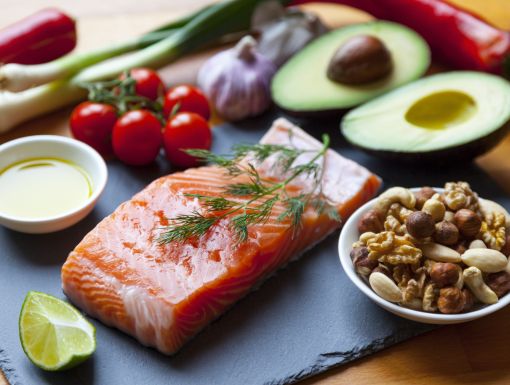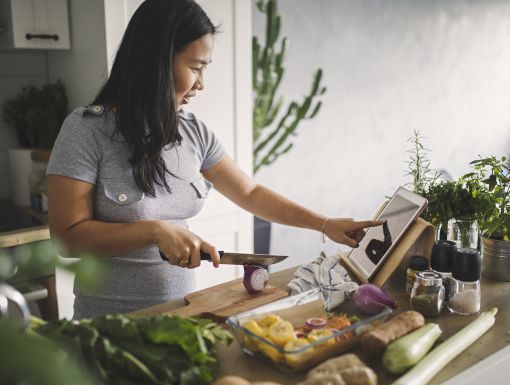
Eating to Manage High Blood Pressure During COVID-19
Based on what we know right now, people with coronary heart disease or hypertension (high blood pressure) may be more susceptible to COVID-19 and are at a greater risk of developing more severe symptoms if they contract the virus.
This means that it’s more important than ever before for people with hypertension to be proactive about keeping their blood pressure well-controlled and maintaining good health and nutrition.
In addition to continuing to take your medications as prescribed, incorporating regular exercise into your lifestyle and keeping follow-up appointments (either in person or virtually), it’s essential to be mindful of your diet.
The DASH Diet
The DASH diet is often recommended for people with hypertension. DASH stands for Dietary Approaches to Stop Hypertension, and has been shown to reduce blood pressure in as little as two weeks.
The DASH diet is simple and consists of the following five key components:
- Potassium-rich foods: vegetables (fresh or frozen), whole fruits and low-fat dairy products
- Emphasis on plant-based fats (such as avocado, nuts, olive oil); limiting animal fats and trans fats
- Lean proteins such as fish and poultry
- Whole grains in place of white, refined starches
- Cut back on sugar, sodium, sugary drinks and red meat
If you haven’t started following the DASH diet, you can do so now by making gradual changes. One of the biggest improvements we can make is to cut out any sugar-sweetened drinks including soft drinks, sports drinks, sugary coffee drinks, fruity drinks, lemonade and sweet tea. Replace these with water or if you’re looking for flavor, try water with a squeeze of lemon or lime, flavored sparkling water or herbal teas.
To dial back on sodium, start with trading in the salt shaker, adding flavor instead with spices, fresh or dried herbs, and low- and no-salt seasoning blends.
To schedule a virtual nutrition consultation, call 985-898-7050 or email nutrition@ochsner.org.
It’s important to know that an estimated 77% of our sodium intake comes from processed foods and restaurant foods, so it can be challenging limit our sodium intake unless we’re preparing foods at home. Consider checking out the Eat Fit Cookbook for heart-healthy recipes you can make in your own kitchen. The Eat Fit app can also guide you in preparing nutritious dishes and locating Eat Fit-approved restaurants near you. Download it via the iTunes App Store.
More Tips for Eating for Heart Health
The following tips will help keep you on track as you aim to improve your eating habits.
- Top sneaky sodium culprits include salad dressing, breads and cheese, as well as not-so-stealthy sodium bombs like deli meats, breakfast cereals, broths and soups, and fast food. Avoid these when possible, or look for low-sodium varieties of these foods.
- Add at least one cup of vegetables to lunch and dinner, and add a cup fruit as part of a snack.
- Note that most canned and dried fruits are high in sugar, but frozen fruit can be just as nutritious as fresh; just check the label to confirm no added sugar.
- Limit alcohol and caffeine intake, or cut it out completely. Try replacing them with these refreshing low- and no-sugar mocktails or herbal tea.
- Limit red meat to once or twice a week and try making some meals vegetarian. (See these tips for going meatless or eating meat less during the quarantine.)
- Instead of snacking on chips or sweets, reach for 2% low-fat Greek yogurt topped with fruit, raw or grilled veggies dipped into creamy dip made with Greek yogurt in place of mayo or sour cream, or apple slices or whole grain crackers topped with peanut butter or almond butter.
- Be aware that not all “natural” supplements and home remedies are safe, and some may interact with medications. Licorice, for example, can raise blood pressure. Always consult your doctor before consuming any new supplements or herbs.
For more tips on how to maintain a heart-healthy diet, check out my segment on WGNO
or my FUELED podcast interview with Ochsner’s Dr. Milani.
Editor's note: This article was originally published on April, 23, 2020.
The information in this blog post is accurate as of November, 22, 2021. However, as the situation surrounding COVID-19 continues to change, it's possible that information has changed since being published. While Ochsner Health is trying to keep our blog posts as up-to-date as possible, we also encourage readers to stay informed on news and recommendations by using the CDC website.



